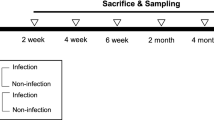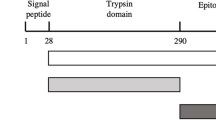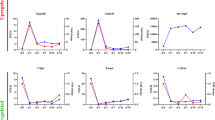Abstract
Purpose
Dystrophin and the dystrophin glycoprotein complex serve as a cytoskeletal integrator, critical for muscle membrane stability. The aim of the present study was to clarify the expression of dystrophin protein and mRNA in the skeletal muscle tissue during the muscle phase of trichinellosis in mice.
Methods
Muscle tissue was collected from mice experimentally infected with Trichinella spiralis at days 0, 14 and 40 after infection. The expression of dystrophin in the muscle tissue was investigated by immunohistochemistry with antibodies against three different domains of the protein, and the expression levels of Dys mRNA by real-time PCR.
Results
The presence of dystrophin protein was increased in the de-differentiating cytoplasm at the early stage of muscle infection and was persisting also in the mature Nurse cell harbouring the parasite. It was accompanied by significantly elevated expression of Dys mRNA at days 14 and 40 after infection.
Conclusion
Our findings indicate that dystrophin plays a role in regeneration of the muscle and in the Nurse cell formation and stability for security of the parasite survival.



Similar content being viewed by others
Data availability
The datasets generated and analyzed during the current study are available from the corresponding author on reasonable request.
References
Capó V, Despommier DD (1996) Clinical aspects of infection with Trichinella spp. Clin Microbiol Rev 9:47–54. https://doi.org/10.1128/cmr.9.1.47
Despommier DD (1998) How does Trichinella spiralis make itself at home? Parasitol Today 14:318–323. https://doi.org/10.1016/s0169-4758(98)01287-3
Lapidos KA, Kakkar R, McNally EM (2004) The dystrophin glycoprotein complex. Signalling strength and integrity for the sarcolemma. Circ Res 94:1023–1031. https://doi.org/10.1161/01.RES.0000126574.61061.25
Jasmer DP (1993) Trichinella spiralis infected skeletal muscle cells arrest in G2/M cease muscle gene expression. J Cell Biol 121:785–793. https://doi.org/10.1083/jcb.121.4.785
Milcheva R, Janega P, Celec P, Petkova S, Hurniková Z, Izrael-Vlková B, Todorova K, Babál P (2019) Accumulation of α-2,6-sialoglycoproteins in the muscle sarcoplasm due to Trichinella sp. invasion. Open Life Sci 14:470–481. https://doi.org/10.1515/biol-2019-0053
Cox ML, Schray CL, Luster CN, Stewart ZS, Korytko PJ, Khan KNM, Paulauskis JD, Dunstan RW (2006) Assessment of fixatives, fixation, and tissue processing on morphology and RNA integrity. Exp Mol Pathol 80:181–191. https://doi.org/10.1016/j.yexmp.2005.10.002
Zarlenga DS, Chute MB, Martin A, Kapel CMO (2001) A single, multiplex PCR for differentiating all species of Trichinella. Parasite 8:S24–S26. https://doi.org/10.1051/parasite/200108s2024
Ye J, Coulouris G, Zaretskaya I, Cutcutache I, Rozen S, Madden T (2012) Primer-Blast: a tool to design target-specific primers for polymerase chain reaction. BMC Bioinform. https://doi.org/10.1186/1471-2105-13-134
Zhang JD, Ruschhaupt M, Biczok R (2014) ddCt method for qRT-PCR data analysis. Retrieved October 2021 from http://bioconductor.jp/packages/2.14/bioc/vignettes/ddCt/inst/doc/rtPCR.pdf
Blake DJ, Weir A, Newey SE, Davies KE (2002) Function and genetics of dystrophin and dystrophin-related proteins in muscle. Physiol Rev 82:291–329. https://doi.org/10.1152/physrev.00028.2001
Hoffman EP, JrRH B, Kunkel LM (1987) Dystrophin: the protein product of the Duchenne muscular dystrophy locus. Cell 51:919–928. https://doi.org/10.1016/0092-8674(87)90579-4
Cox GA, Cole NM, Matsumura K, Phelps SF, Hauschka SD, Campbell KP, Faulkner JA, Chamberlain JS (1993) Overexpression of dystrophin in transgenic mdx mice eliminates dystrophic symptoms without toxicity. Nature 364:725–729. https://doi.org/10.1038/364725a0
González E, Montañez C, Ray PN, Howard PL, García-Sierra F, Mornet D, Cisneros B (2000) Alternative splicing regulates the nuclear or cytoplasmic localization of dystrophin Dp71. FEBS Let 482:209–214. https://doi.org/10.1016/s0014-5793(00)02044-5
Bajanca F, Gonzales-Perez V, Gillespie SJ, Beley C, Garcia L, Theveneau E, Sear RP, Hughes SM (2015) In vivo dynamics of skeletal muscle Dystrophin in zebrafish embryos revealed by improved FRAP analysis. Elife 4:e06541. https://doi.org/10.7554/eLife.06541
Babál P, Milcheva R, Petkova S, Janega P, Hurniková Z (2011) Apoptosis as the adaptation mechanism in survival of Trichinella spiralis in the host. Parasitol Res 109:997–1002. https://doi.org/10.1007/s00436-011-2343-2
Dumont NA, Wang YX, von Maltzahn J, Pasut A, Bentzinger CF, Brun CE, Rudnicki MA (2015) Dystrophin expression in muscle stem cells regulates their polarity and asymmetric division. Nat Med 21:1455–1463. https://doi.org/10.1038/nm.3990
Kang YJ, Jo JO, Cho MK, Yu HS, Cha HJ, Ock MS (2012) Trichinella spiralis infection induces β-actin co-localized with thymosin β4. Vet Parasitol 187:480–485. https://doi.org/10.1016/j.vetpar.2012.01.017
Khaitlina S (2001) Functional specificity of actin isoforms. Int Rev Cytol 202:35–98. https://doi.org/10.1016/s0074-7696(01)02003-4
Bai X, Wu X, Wang X, Liu X, Song Y, Gao F, Miao Y, Yu L, Tang B, Wang X, Radu B, Vallee I, Boireau P, Wang F, Zhao Y, Liu M (2012) Inhibition of mammalian muscle differentiation by excretory secretory products of muscle larvae of Trichinella spiralis in vitro. Parasitol Res 110:2481–2490. https://doi.org/10.1007/s00436-011-2789-2
Taylor PJ, Hagen J, Faruqu FN, Al-Jamal KT, Quigley B, Beeby M, Selkirk ME, Sarkies P (2020) Trichinella spiralis secretes abundant unencapsulated small RNAs with potential effects on host gene expression. Int J Parasitol 50:697–705. https://doi.org/10.1016/j.ijpara.2020.05.008
Cachiarelli D, Incitti T, Martone J, Cesana M, Cazzella V, Santini T, Sthandier O, Bozzoni I (2011) miR-31 modulates dystrophin expression: new implications for Duchenne muscular dystrophy therapy. EMBO Rep 12:136–141. https://doi.org/10.1038/embor.2010.208
Wu Z, Sofronic-Milosavljevic L, Nagano I, Takahashi Y (2008) Trichinella spiralis: nurse cell formation with emphasis on analogy to muscle cell repair. Prasites Vectors. https://doi.org/10.1186/1756-3305-1-27
Milcheva R, Todorova K, Georgieva A, Petkova S (2022) The synthesis of UDP-N-acetylglucosamine 2-epimerase/N-acetylmannosamine kinase (GNE), α-dystroglycan, and β-galactoside α-2,3-sialyltransferase 6 (ST3Gal6) by skeletal muscle cell as a response to infection with Trichinella spiralis. Helminthol 3:217–225. https://doi.org/10.2478/helm-2022-0027
Nakamura K, Tsukamoto Y, Hijiya N, Higuchi Y, Yano S, Yokoyama S, Kumamoto T, Moriyama M (2010) Induction of GNE in myofibers after muscle injury. Pathobiol 77:191–199. https://doi.org/10.1159/000292652
Acknowledgements
This work was financially supported by the Bulgarian National Science Fund under Grant DN01/16.
Author information
Authors and Affiliations
Contributions
PB and RM—conceptualization and design of research. RM, IM, KT, VD and SP—performance of research. PB, IM, RM, KT and VD—data analysis. RM—manuscript writing. PB—improvement and final edition of manuscript.
Corresponding author
Ethics declarations
Conflict of interest
The authors declare no conflict of interest.
Additional information
Publisher's Note
Springer Nature remains neutral with regard to jurisdictional claims in published maps and institutional affiliations.
Rights and permissions
Springer Nature or its licensor (e.g. a society or other partner) holds exclusive rights to this article under a publishing agreement with the author(s) or other rightsholder(s); author self-archiving of the accepted manuscript version of this article is solely governed by the terms of such publishing agreement and applicable law.
About this article
Cite this article
Milcheva, R., Mečiarová, I., Todorova, K. et al. Trichinella spiralis (Owen, 1835) Induces Increased Dystrophin Expression in Invaded Cross-striated Muscle. Acta Parasit. 68, 393–399 (2023). https://doi.org/10.1007/s11686-023-00673-2
Received:
Accepted:
Published:
Issue Date:
DOI: https://doi.org/10.1007/s11686-023-00673-2




